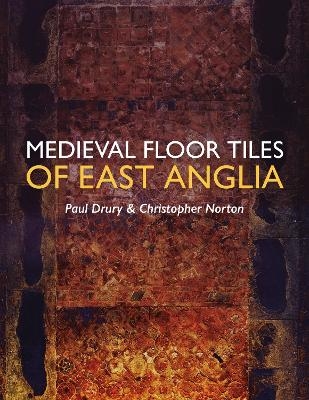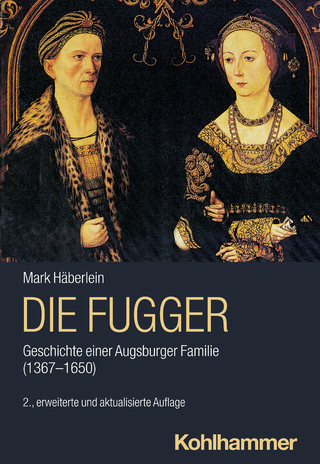
Medieval Floor Tiles of East Anglia
Oxbow Books (Verlag)
978-1-78925-983-4 (ISBN)
- Noch nicht erschienen (ca. Dezember 2025)
- Versandkostenfrei
- Auch auf Rechnung
- Artikel merken
The medieval floor tiles of East Anglia span a period of some four centuries and include an unusual variety of decorative techniques and styles. This study traces their manufacture and use in the historic counties of Essex, Suffolk, Norfolk and Cambridgeshire, identifying their distinctive characteristics in comparison with other regions of England, Flanders and northern France. The tiles are also considered in the context of other ceramic building materials in a region that adopted their use early, as well as their relationship to the other decorative arts and crafts that contributed to the appearance of medieval interiors.The sporadic introduction of glazed tiles, some decorated with compass-incised or high relief designs, began around the mid-12th century at high-status royal and monastic sites. The use of decorative tiles accelerated during the mid–late 13th century, with new types appearing, including mosaic, relief and two-color tiles. While London was an important influence and source, production became established elsewhere, seemingly focused on supplying monastic houses.The first half of the 14th century saw settled production at a range of scales, with sub-regional styles emerging, alongside widening patronage including many parish churches. Some production groups have wide distributions, the designs influenced by earlier styles but introducing new elements and new techniques, like line-impressed mosaics and stenciled slip designs. They existed alongside other production centers serving smaller areas with eclectic derivative designs.In the second half of the 14th century, there were fewer centers mostly producing tiles by less labor-intensive means. The import of small plain color tiles (and occasionally decorated ones) from Flanders, laid checker-wise, grew in importance; by the end of the century almost all parish churches and many burgess houses had some glazed tiles. Subsequently large plain tiles, imported and local, became the norm, enlivened by very localized production of decorated large quarries, until the use of glaze on earthenware tiles ceased during the later 16th century.
Paul Drury specialises in an archaeological approach to understanding major buildings, particularly of the 16th and 17th centuries. His interest in floor tiles originated in contextualising the products of a medieval tile factory he excavated in Essex in 1974. He has published widely and served as President of the Society of Antiquaries, 2019–2021. Christopher Norton is Emeritus Professor of Medieval Art and Architecture at the Centre for Medieval Studies and the Department of the History of Art at the University of York. He is the leading authority on medieval floor tiles in France and has published widely on medieval floor tiles on the continent and in Britain.
1. Introduction
The region: Topography, medieval settlement pattern, major centres, ports and navigable rivers, major trade routes
Sources: Nature and limitations of evidence (extant, excavated, documented)
The evolution of the project and its methodology
2. The manufacture and use of floor tiles in East Anglia: An overview
Making and using tiles: techniques of decoration (including defining terms used); evidence for the organisation of the industry and the trade in tiles in the region; relationship to developments in manufacture and use of other ceramic building materials, and availability of other durable flooring materials.
Tentative steps: Twelfth and early 13th century, incised, bold relief, plain; all isolated examples, context of introduction of CBM generally, high status patrons.
Decorative diversity: Mid-Late 13th century introductions, the importance of London (Westminster tiler and the emergence of the Norfolk industry), Tyler Hill imports, Central Essex Group, Orford (early inlaid and relief), Castle Acre, the sources and influences of the designs and styles, patronage including importance of monastic houses.
Regional styles: First half of 14th century, to (approx.) Black death; settled production at a range of scales, sub-regional styles emerge, widening patronage, use in parish churches becomes common. Line-impressed mosaic, Suffolk relief tiles, Norfolk two-colour have wide distributions, designs influenced by earlier introductions plus new strands; alongside factories serving smaller areas with derivative styles, including Danbury (excavated factory) and Oulton.
Retrenchment and simplification: Second half of C14 (post Black Death), fewer production centres, dominance of relief tiles (Bawsey, Ipswich), start of Flemish plain tile imports (and occasionally decorated) bringing fashion for geometric floors, but inlaid tiles of Drinkstone group are a high-quality innovation around the end of the century. Virtually all churches have some tiles, increasing use in houses.
Chequerboard floors and special orders: Normalised use of large quarries laid chequer fashion, imported and local, 15th and early 16th centuries; locally produced decorated tiles (and continental imports including from Spain) occasionally occur, mostly in same module and to special order.
Conclusions: Including regional character summarised; relationship to other decorative arts (stone, glass, iron) in the region; patterns of tile supply to sites; comparison with tile use and design in other English regions, Flanders and Northern France; interplay with other regions through import/ export of styles, tiles and tilers.
3. The production groups
Catalogue, generally arranged under the headings of the overview in approximately chronological order, but with close derivatives following their principal group. Each group entry comprises description (including drawings of designs where decorated and illustrations of pavements, rare in region), distribution (with small map), discussion and dating evidence. Working numbers used here will be rationalised.
[Tentative steps]
G1 Orford incised (PSIA 36 (1985),1-7), G2 St Albans and Sibton relief, G3 thick early relief, G4 derivative of G3, G5 Shouldham (plain), G6 Colne, G7 Coggeshall
[Early introductions and their evolution]
G25 Stratford Langthorne mosaic/ two colour, G9 Castle Acre, G10 Butley, G40-41 Wessex, G45 Chertsey-Westminster, G50-53 mosaic
G20-23 Westminster tiler series
G11-12 Waltham Abbey Primary/ Secondary, G13 West Essex, G14 Horsham St Faith/ G15-16 Norfolk first and second, G17 Hempstead, a sequence from mid C13 to mid-late C14
G30 Central Essex A-F, G35 Stebbing
[Regional styles]
G131 Tyler Hill, G 132 Penn, G149 Decorated Mosaic (all made outside region but distributed within parts of it)
G56 Principal group line impressed, G55 Coggeshall Abbey Mosaic, G58 Essex line impressed mosaic
G65 Line-impressed and stencilled group
G59, 66-69 Small groups of local derivatives of G55-6, 65
G130 Danbury (Med Archaeol 19, (1974), 92-164)
G120-126, 199 Small localised groups of regional C14 two-colour tiles
G140, 143-144, 150, 190 Small localised groups of probably imported two colour tiles
G97 Suffolk Relief tiles (large, widespread group)
G87, 88, 95, 98, 180 Small localised groups of relief tiles, Suffolk
G100 Oulton (PSIA 44.2, 2018, 194-213)
G141 Hollesley
G151-2 Mill Green
[Retrenchment and simplification]
G105 Bawsey (relief) and G106 small group relief tiles
G85 Ipswich (relief and stencil)
G86 Stencilled tiles derived from G85
G77 Colchester relief tiles
G160-1, 170-1 Plain colour tiles, Flemish and local
G116 Drinkstone, high quality decorated c1380-1420; an exception to the trend
[Chequerboard floors and special orders]
G162-2, 172-3 Large plain colour tiles, Flemish and local
G175 Large plain green glazed tiles, North French
G155-158 Diagonally divided two colour tiles, G159 triangular tiles
G201, 203-5, 209-10, 213-4, 215, 217 Large quarries variously decorated, each with restricted distribution
G216 Little Sampford tiles
G200 Waltham Abbey Relief tiles
G211 Burgundian imports
G218 Flemish motto tiles
G191 Spanish imports
4. Site gazetteer
Overview of museum and other collections
Sites, in alphabetical order across the region, including site plans and photographs where appropriate, and comment on tile supply where multiple groups present
Appendices
1 . Medieval documentary references to floor tiles in East Anglia (David Sherlock)
Bibliography
Index
| Erscheint lt. Verlag | 15.12.2025 |
|---|---|
| Zusatzinfo | 250 b/w and color imgaes |
| Verlagsort | Oxford |
| Sprache | englisch |
| Maße | 211 x 297 mm |
| Themenwelt | Geisteswissenschaften ► Archäologie |
| Geschichte ► Allgemeine Geschichte ► Mittelalter | |
| Geisteswissenschaften ► Geschichte ► Regional- / Ländergeschichte | |
| ISBN-10 | 1-78925-983-5 / 1789259835 |
| ISBN-13 | 978-1-78925-983-4 / 9781789259834 |
| Zustand | Neuware |
| Informationen gemäß Produktsicherheitsverordnung (GPSR) | |
| Haben Sie eine Frage zum Produkt? |
aus dem Bereich


